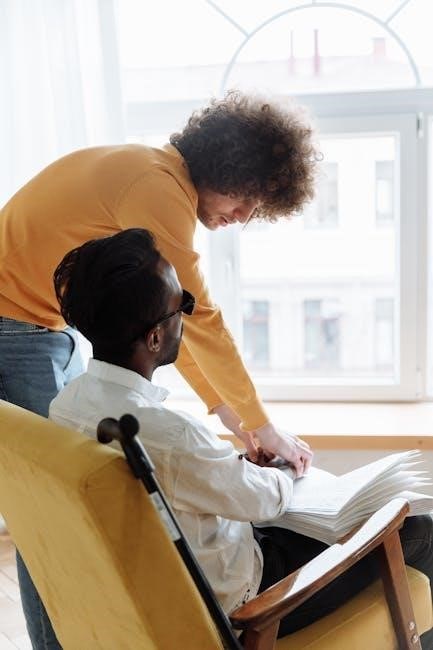Internalized homophobia refers to the internalization of homophobic messages, leading to self-hatred, shame, and mental health struggles. It stems from societal norms and negative stereotypes about LGBTQ+ individuals.
1.1 Understanding the Concept of Internalized Homophobia
Internalized homophobia occurs when individuals accept and internalize negative societal attitudes toward LGBTQ+ people, leading to feelings of self-hatred and shame. This concept arises from the absorption of homophobic messages perpetuated by culture, family, or religion, which can result in a distorted self-image. It manifests as self-loathing, low self-esteem, or even self-destructive behaviors, as individuals struggle to reconcile their true identity with societal expectations. Internalized homophobia can also lead to the suppression of one’s sexual orientation or gender identity, further exacerbating emotional pain. Understanding this concept is crucial for addressing the deep-seated psychological wounds it inflicts and for fostering self-acceptance and empowerment. Recognizing these internalized beliefs is the first step toward healing and reclaiming one’s authentic self.
1.2 The Importance of Addressing Internalized Homophobia
Addressing internalized homophobia is essential for fostering mental health and well-being among LGBTQ+ individuals. Left unchallenged, it can lead to chronic self-hatred, anxiety, depression, and even suicidal thoughts. By acknowledging and confronting these internalized beliefs, individuals can break free from the cycle of shame and self-doubt. Healing from internalized homophobia allows for greater self-acceptance, improved relationships, and a more authentic life. It also empowers individuals to challenge heteronormative norms and advocate for a more inclusive society. Ignoring this issue perpetuates suffering, while addressing it promotes personal growth and collective progress. Recognizing the importance of this journey is the first step toward liberation and empowerment for LGBTQ+ individuals.

The Psychological Impact of Internalized Homophobia
Internalized homophobia often manifests as self-hatred, anxiety, and depression, profoundly affecting mental health and self-esteem. It can lead to emotional turmoil and identity conflicts.
2.1 How Internalized Homophobia Leads to Shame and Self-Hatred
Internalized homophobia fosters deep-seated shame and self-hatred by internalizing negative societal messages about being LGBTQ+. This leads to a belief that one’s identity is flawed or unacceptable, creating emotional turmoil. Shame arises from the fear of rejection and judgment, while self-hatred develops as individuals struggle to reconcile their true selves with societal expectations. These feelings often manifest as self-criticism, low self-esteem, and difficulty accepting one’s orientation or gender identity. The internalization of homophobic attitudes can also result in self-destructive behaviors and mental health issues. Recognizing these patterns is crucial for understanding the psychological toll of internalized homophobia and beginning the process of healing and self-acceptance.
2.2 The Connection Between Internalized Homophobia and Mental Health
Internalized homophobia is deeply linked to mental health challenges, often resulting in anxiety, depression, and low self-esteem. The internalization of negative societal messages can lead to chronic self-doubt and emotional distress. Individuals may experience feelings of guilt, inadequacy, and isolation, which can exacerbate mental health struggles. The psychological burden of hiding one’s true identity can also contribute to stress and emotional turmoil. Furthermore, internalized homophobia can hinder individuals from seeking support, worsening mental health outcomes. Addressing these internalized beliefs is essential for promoting mental well-being and fostering resilience within the LGBTQ+ community. By acknowledging the impact of internalized homophobia, individuals can begin to heal and develop a more compassionate relationship with themselves. This connection underscores the importance of targeted interventions and supportive environments.

Societal and Cultural Factors Contributing to Internalized Homophobia
Societal norms, such as heteronormativity and rigid gender expectations, perpetuate internalized homophobia by promoting negative stereotypes about LGBTQ+ individuals, fostering feelings of shame and self-hatred.
Heteronormative norms, which assume heterosexuality as the standard, play a significant role in fostering internalized homophobia. These norms often perpetuate rigid gender expectations, reinforcing the idea that being LGBTQ+ is abnormal or unacceptable. As a result, individuals may internalize these messages, leading to feelings of shame, guilt, and self-doubt. Societal expectations around marriage, family, and relationships further entrench these norms, making it difficult for LGBTQ+ individuals to embrace their identities. The constant exposure to heteronormative values in media, education, and daily life contributes to the internalization of homophobic beliefs, creating a cycle of self-hatred and alienation. Overcoming these deeply ingrained norms requires education, awareness, and the dismantling of systemic heteronormativity. Negative messages about LGBTQ+ individuals are a cornerstone of internalized homophobia. These messages, often perpetuated by society, media, and even family, portray being LGBTQ+ as unnatural, immoral, or lesser. When individuals repeatedly encounter such harmful narratives, they begin to internalize them, leading to feelings of shame, guilt, and self-hatred. These messages can come from overt sources, such as discriminatory laws or homophobic rhetoric, or subtle ones, like the absence of LGBTQ+ representation in media. Over time, this internalization fosters a deep-seated belief that there is something wrong with being LGBTQ+, contributing to low self-esteem and mental health struggles. Addressing these negative messages is crucial for healing and fostering self-acceptance. Education, self-compassion, and building supportive communities are key strategies to combat internalized homophobia. These approaches foster self-acceptance and resilience, helping individuals heal from shame and self-hatred. Education is a powerful tool in overcoming internalized homophobia. By learning about LGBTQ+ history, rights, and contributions, individuals can challenge harmful stereotypes and misconceptions. Understanding the experiences of others fosters empathy and self-acceptance. Engaging with resources like books and workshops helps dismantle ignorance and promotes inclusivity. This awareness not only empowers individuals to reject negative societal messages but also encourages them to embrace their authentic selves. Through education, people can begin to heal from internalized shame and build a stronger sense of identity. It is a crucial step toward personal growth and societal change. Surrounding oneself with a supportive community is vital in overcoming internalized homophobia. Connecting with others who understand and share similar experiences fosters a sense of belonging and acceptance. Supportive networks, whether online or in-person, provide a safe space to express emotions and challenges without fear of judgment. Engaging with LGBTQ+ communities and allies can help individuals rebuild their self-esteem and confidence. These connections often lead to meaningful relationships that counteract the harmful effects of internalized shame. A strong support system encourages personal growth and empowers individuals to embrace their true selves, ultimately aiding in the healing process from self-hatred and guilt. Building such a network is a cornerstone of overcoming internalized homophobia and achieving mental well-being. Self-compassion and self-acceptance are essential for healing from internalized homophobia. Recognizing and challenging negative self-perceptions allows individuals to replace shame with kindness and understanding. Practicing self-compassion involves acknowledging one’s humanity and accepting flaws as natural. This process helps diminish the grip of internalized homophobia by fostering a positive self-image. Self-acceptance, in turn, empowers individuals to embrace their identity without apology. Both practices are vital for rebuilding self-esteem and moving beyond the harmful effects of internalized shame. By cultivating self-compassion and acceptance, individuals can develop resilience and live authentically, free from the burdens of self-hatred and guilt. These practices are foundational to the healing journey outlined in guides addressing internalized homophobia. Key resources include Internalized Homophobia: A Guide to Overcoming Shame and Self-Hatred and The Internalized Homophobia Workbook. Therapy and support groups also play a crucial role. Internalized Homophobia: A Guide to Overcoming Shame and Self-Hatred is a transformative resource offering practical strategies to address internalized homophobia. This guide provides insights into recognizing patterns of self-hatred and guilt, while fostering self-compassion. Another valuable resource is The Internalized Homophobia Workbook, which offers exercises to help individuals reframe negative beliefs and build self-acceptance. These books are complemented by works like The Velvet Rage by Alan Downs, which explores the challenges of growing up gay in a heteronormative world. Together, these resources provide a roadmap for healing, empowering individuals to move from shame to authenticity and self-love. They are essential tools for personal growth and understanding the complexities of internalized homophobia. Therapy plays a crucial role in addressing internalized homophobia, offering a safe space for individuals to explore their feelings and experiences. Professional guidance helps individuals identify and challenge harmful beliefs rooted in societal norms. Therapists trained in LGBTQ+ issues can provide tailored strategies to combat self-hatred and foster self-acceptance. Through techniques like cognitive-behavioral therapy, individuals can reframe negative thoughts and develop healthier self-perceptions. Support groups, led by professionals, also provide community and shared understanding, reducing feelings of isolation. Therapy not only aids in healing but also empowers individuals to embrace their authentic selves, moving beyond the confines of internalized homophobia. Professional guidance is a vital component in the journey toward mental health and self-acceptance. Overcoming internalized homophobia is a journey of self-discovery and healing, requiring courage, support, and self-compassion. By addressing the root causes of shame and self-hatred, individuals can reclaim their authenticity and embrace their true selves. Education, therapy, and community support are essential tools in this process. Surrounding oneself with inclusive environments and fostering self-acceptance are key to breaking free from harmful societal norms. Healing from internalized homophobia is not just about personal growth but also about empowering others to do the same. Through resilience and determination, individuals can move beyond shame and live authentically, contributing to a more inclusive and accepting world for all LGBTQ+ individuals.3.1 The Role of Heteronormative Norms and Expectations
3.2 The Influence of Negative Messages About LGBTQ+ Individuals

Strategies for Overcoming Internalized Homophobia
4.1 Education and Awareness About LGBTQ+ Issues
4.2 Building a Supportive Community and Network
4.3 The Power of Self-Compassion and Self-Acceptance

Recommended Resources for Healing
5.1 Books and Workbooks on Internalized Homophobia
5.2 The Role of Therapy and Professional Guidance

